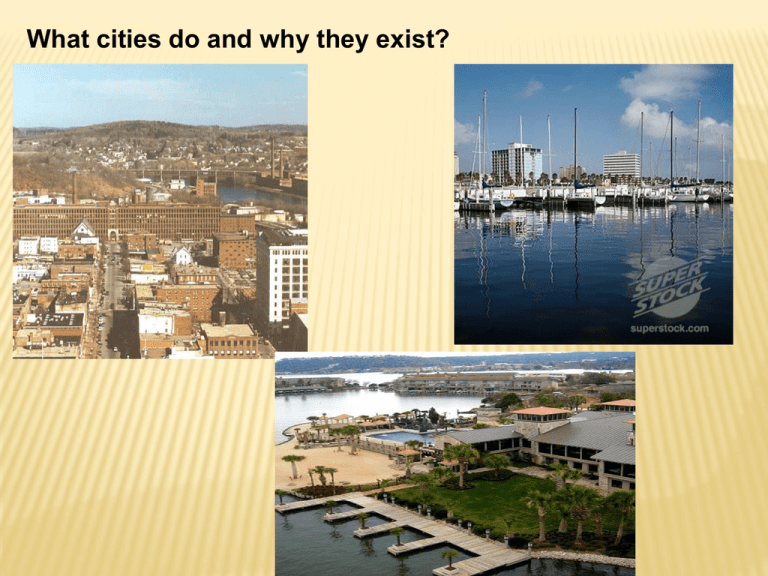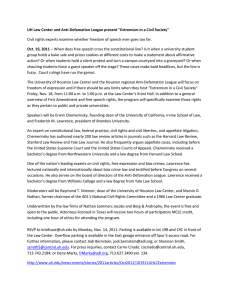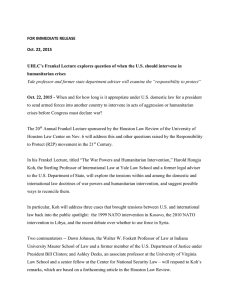WHAT CITIES DO AND WHY THEY EXIST.
advertisement

What cities do and why they exist? WHAT CITIES DO AND WHY THEY EXIST. “Cities are the most important human made feature on the Earth’s surface.” Urbanization has been the major trend in the 20th century. Cities exist to provide? The development of agriculture some 10,000 years ago made cities possible. With a surplus of food, not all people had to be concerned about growing food. This allowed “specialization of labor.” Different people could produce different products and trade. People could produce shoes, clothes, swords, etc… and barter for food and other products. Urban settlements The “urban revolution” began in the Fertile Crescent. Other cities in that age group could be found in Egypt, the Indus Valley, and in China. By 2,500 BC there were cities in Knossos, Crete and Mycenae in Greece. These were trading centers that developed into citystates which governed the city and farmlands around them. The physical geography of the region is a major determinant in place people choose to settle. Site: has to do with the physical characteristics of a place or its absolute location. Situation has to do with a place’s relationship with other locations, or its relative location. There is an hierarchy in urban development A settlement may have less have 500 people or less. Most of the people will be involved in a single economic activity. A village will have a population of 500-2500. People of a village may be tied to one economic activity, but… there will also be a few low level services to support the local economic activity. A town will have a population of 2,500 to 20,000 A town may have a major employer, but there will be several other companies or businesses that employ a number of people. There will be a variety of nonbasic industries available. A city will have a population from 20,000 to several million. The city will have a variety of basic and non-basic industries. Cities must “do something” to exist. CITIES EXIST BECAUSE THEY ARE P.I.G.S. PORTS INDUSTRIAL CENTERS GOVERNMENT CENTERS SERVICES New York City Mexico City London Houston Cities must have a reason to exist. What happens when the mines are exhausted? Central Place: provides goods and services to the surrounding areas (hinterlands.) Chicago sits on Lake Michigan, Chicago River, and a vast system of rail lines. It is a central place for the Midwest. Amarillo serves as a “central place” for the small towns and farms in the Panhandle (hinterlands.) How about Houston? Wheat farms Cadillac Ranch on I-40. A central place provides goods and services for a region. Cites can exist because they are transportation centers. Technology can change the mode of transpiration . A metropolitan area is made up of a central business district and rings that include small surrounding cities (exurbs-Hempstead), built up areas around a central city (suburbs –Cy Fair), and the central city (inside loop 610. Houston Metropolitan Area Suburbs CBD Cy Fair Exurbs Galveston Cites are also “break of bulk” centers. This means goods are moved from one mode of transportation to another. Ships to trucks, trains or trains to trucks. These goods are then shipped out to stores and end users. Houston grew into a major city because it is a transportation center Rail, two air ports, the ship channel and interstate highways. Of course Houston’s growth is also tied to… The energy capital of the world (oil!) Which American city grew into a great city because of the automobile industry? Detroit NUMBER OF VACANT ADDRESSES IN DETROIT -- 2009 Cities exist for special purposes, like……….? This special purpose city is the entertainment capital of Texas. Centers for special activities may be the seat of government (county, state, or national. They may also exist because they are the central place of a religion If the functions of a city or town increase in number of importance, it will grow in population. When the functions decrease, or the basic industry decreases, the entire economy of the city experiences a downturn. If a city decreases in importance, its population will decline Timbuktu, Mali, West Africa Over 50% of the world’s population now lives in cities (much higher in the developed world.)











